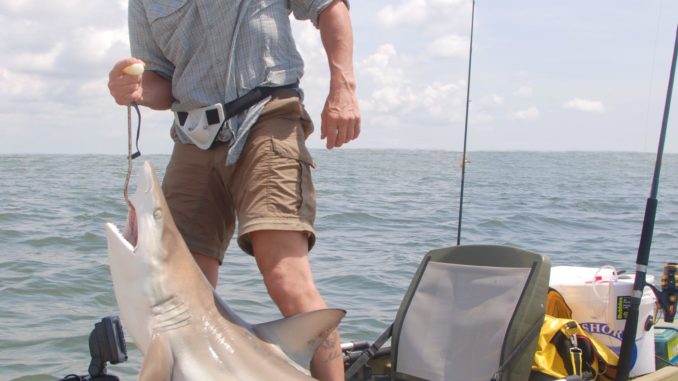
Precaution should be a paddler’s first concern
As a student in high school, Ernest Hemingway’s The Old Man and The Sea was required reading. Without sounding unappreciative of classic literature, who wouldn’t love to be pulled around in a small boat by a massive blue marlin? Personal preference would be on rod-and-reel with a serious drag system rather than a hand line. Three hours would suffice to have the experience and minimize the drama of being lost at sea for three days. Oh, and catch-and-release would absolve you of having to battle giant sharks for your catch. They’d just have to wait their turn, after the marlin was released.
Many kayak anglers yearn for that saltwater sleigh ride and take what they can get, substituting sharks, cobia, jacks or kings for Gulf Stream marlin. Unlike Santiago, most who tread outside the surf don’t have a lot of experience with the open ocean in a small boat. Like raging river currents and storms inland, braving the elements carries a degree of risk.
With the thought that you gotta learn sometime, advice was solicited from a few old salts to help you prepare so your first day beyond the breakers won’t also be your last day,
Mike Eady, a Grand Strand area kayak-fishing guide, typically takes clients inshore but will on occasion and with personal knowledge of their skill level, lead a few trips outside the Murrells Inlet jetties. Eady said with any trip, safety comes first, but even more out in the open.
“Wear bright colors. You are not as visible as you think you are in the rolling seas. A larger boat moving at a good pace might not be able to see you between swells,” said Eady (843-246-0045). “Your most important piece of safety gear after a PFD is a spare paddle. I broke one once in the surf. I got back to the beach with only one blade and then I had to walk two miles back to the truck.”
Veteran kayaker Tommy Samuels of Summerville has a prepared “Oh shoot” bag that is the first thing he puts in the boat before an offshore outing.
“It depends on the trip and the conditions,” Samuels said. “Most of the time, I’m fishing within two miles of the beach, but here’s what’s in the bag: cell phone in a dry pouch, signal flares, spare paddle, plenty of water and a first-aid kit.”
Bill Howard, who writes a paddling column for North Carolina Sportsman, advises that a redundant GPS system is always a good idea when there’s nothing between you and the United Kingdom but a whole lot of water.
“Just this past year, I had an unexpected storm come up in which visibility went to roughly 50 yards while I was a mile out,” said Howard. “My fish-finder has GPS, and I keep two small batteries as back-ups for it. I also have a marine radio with GPS tracking and GPS enabled one-button distress call. My cell phone also can track GPS even without a cell signal, and I keep two extra batteries for it.”
“Always go with friends and have a marine radio so you can stay in communication,” Eady said. “Sometimes you drift at different speeds, or your buddy may hook up with a nice fish and need assistance. I like to have mine scanning when we go to the nearshore reefs. Some boat captains will let each other know where they have been hooking up and on what baits. Any info helps when you’re miles from shore.”
With the safety piece nailed down, it’s time to do some fishing. Species choices and bait choices will follow the season, whether you’re chasing them in a 100-pound plastic boat or an 8,000-pound fiberglass one.
“We target kings, sharks, black sea bass, whiting and spot, pompano, jacks, cobia, tarpon — whatever will bite a hook,” Eady said. “We usually have larger and smaller rods to handle any species we encounter. If we catch small fish, they might be used as bait for bigger fish on bigger rods. Otherwise, we use mullet, pinfish, shrimp, crabs or artificials for bait. It just depends on the season.”
Having spent a lot of time paddling around Beaufort in his younger days and frequently returning each summer, Brad Knight of Belton makes sure he carries a selection of spoons with him when kayak fishing in the ocean.
“I cast Skitterpops and spoons to schooling Spanish, blues and ladies (ladyfish) on 2500 to 3000 (class) spinning gear. I know Berry’s Flex-it Spoons are for freshwater, but they are hard to beat in nearshore waters,” Knight said. “Black sea bass will kill them on the wrecks, and you can tip them with squid or shrimp if the bite is slow. You can’t reel one through schooling Spanish without hooking up … and they cast a looooooonng way !!”
“I usually try to fish the buoys, mostly bottom-fishing for spot, croaker, black sea bass or flounder,” Howard said. “I don’t mind heading out alone — and usually the artificial-reef buoys have other boats nearby — so I feel pretty safe in that regard, but I do let my wife know the bouy numbers I am targeting just in case of emergency, and also a time she can expect me to at least contact her — more or less a plan.”




Be the first to comment